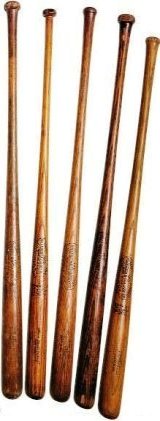|
Bunt And Run ~ The Short Game Adrenalin Rush!
Photo Bill Stanton
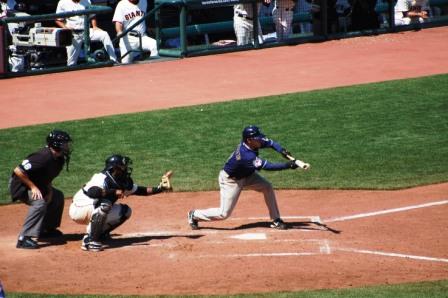
Bunt and run, the short game adrenalin rush! This one creates some instant excitement.
The short version of the hit and run, it is designed to move a runner two bases, as well as having the possibility of the hitter also getting a base hit.
Since the runner(s) are moving on the pitch, the thought is immediate for the defense that they will need to hurry. This has a way of transferring into mental, as well as physical miscues on the part of the defense.
Once the runner (s) start, the first concern becomes steal, and the coverage that must be created. With the added bunt, the communication and reaction gets more complicated. With the ball pushed up the third base line, the pitcher and 3B have to communicate who is fielding the ball, the other must get to third base.
All outfielders have a responsibility to backup somewhere, which does not always happen, even at the MLB level.
The catcher has to make a snap decision on where the play will be made, or the ball held because it is too late. More opportunities for a miscalculation. Properly executed, the odds for success are heavily on the side of the offense.
Another way to, "make your opponent play the game". If he is able to field the balls, make the throws, make the catches, move to all the required backups and execute all the correct communication calls and reactions, you have to tip your hat to him and say,"good job".
What You Are Hoping To See If You Are The Runner From First Base
Photo Bill Stanton
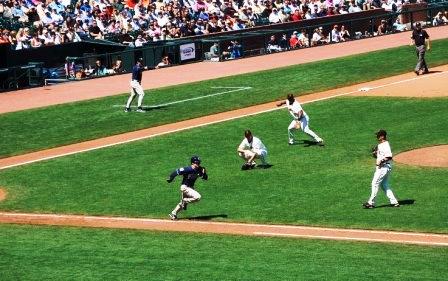
The photo depicts a look that the base runner wants to see, the 3B has come in to field the bunt, the pitcher has also. One will field the bunt, the other needs to cover back to 3B. When you see this, you can keep coming from first base to third base.
Runner On first
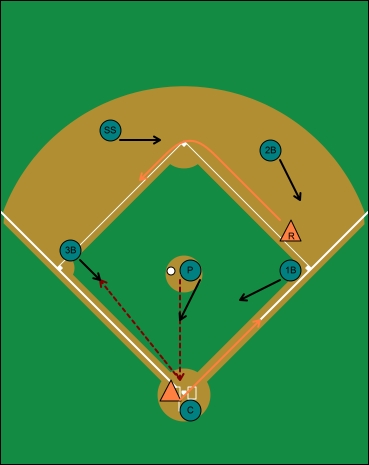
- Hitter is putting the ball on the ground, no matter what the pitch is. If it is not buntable, bring the bat back, which keeps the catcher back.
- Runner is going on the pitch. If there is no contact, it becomes a straight steal.
- Hitter is pushing the ball up the third base line, hard enough to make the third baseman field it.
- Runner comes hard to second, looking to go to third should no one cover third base when the 3B fields the ball. Base runner can read this situation and turn and come to third, or hold at second.
- This play is designed to get the runner to 3B. A well placed ball can easily end up in a base hit, runners at 1B and 3B.
- Creates a lot of pressure and numerous opportunities for the defense to make a mistake.
Runner On Second
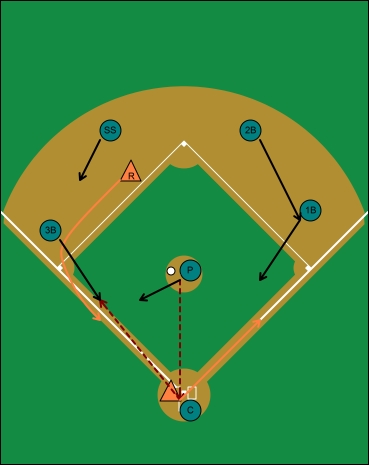
- Hitter is putting the ball on the ground, no matter what the pitch is. If it is not buntable, bring the bat back, which keeps the catcher back.
- Runner is going on the pitch. If there is no contact, it becomes a straight steal.
- Hitter is pushing the ball up the lines, preferably the third base side, hard enough to make the 3B field it.
- Runner comes hard to 3B, looking to make the turn and score. If that is not possible, the third base coach will hold him up.
- Looking to score a run on this play. Well placed ball can score a run and become a base hit as well.
Runners On First and Second
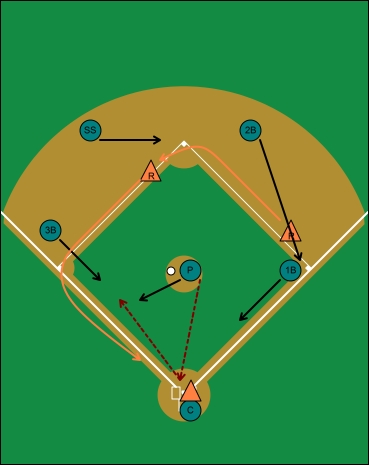
- Hitter is putting the ball on the ground, no matter what the pitch is. If it is not buntable, bring the bat back, which keeps the catcher back.
- Runners are going on the pitch. If there is no contact, it becomes a straight double steal.
- Hitter is pushing the ball up the lines, preferably the third base side, hard enough to make the 3B field it.
- Runner from second is looking to score.
- Runner from first reads the lead runner. He goes, you go. He stops, you stop.
- Best case scenario, one run scored, runners on first and third.
- Two runners, double the pressure on the defense. The possibility is there for the defense to play this situation into a big offensive boost.
Bunt and Run Tips ~ From the Dugout

- Hitters, stay in the box and get the bunt down. It is all about "Location, Location, Location." Bunt, then run!
- Runners read the situation ahead of them, react accordingly.
- Work towards the chalk. If it goes foul, you get to try again. A ball pushed up the line, hard enough to make the 3b come and make the play, provides the offense with the best opportunity for maximum success.
Create As Much Organized Chaos As Possible To See If Your Opponent Can Handle It!
Additional Offensive Situations
- Offensive Situations
Keep your opponents under pressure at all times
- Sacrifice bunts
The cornerstone's of offensive situations
- Hit and run
Get your offense moving with this exciting and aggressive play
- Fake bunt and steal
A great wrinkle to enhance the straight steal, providing your base runner with a little extra protection
- Fake bunt and hit
An effective way to get the defense to react to what they see, then the offense executes something entirely different
- Reading down angles
Get the jump on pitches in the dirt, take the extra base
- Special plays
Designed to amp up your running game through the element of surprise
- Safety squeeze
Initially the safest version, yet the most complicated to execute
- Suicide squeeze
A few seconds of pure excitement
- Double squeeze
The excitement of the suicide squeeze, with so much more
- Base running
One of the least taught, yet still one of the most important, even in the age of the aluminum bat
- Stealing second
As you step out into your lead, all the feelings intensify as you lock in on that one movement the pitcher is about to make, a movement that will send you speeding towards second base
- Stealing third
Often easier than stealing second
- Steal home
Always exciting and a true defensive demoralizer
- Double steal
Working to keep up the pressure, get two runners into scoring position or possibly score a run
- Delayed steal
Uses the element of surprise, a great equalizer
- Home to first
A full out sprint; remember, hustle never has a bad day
- First to second
Stay in the moment, be aggressive
- Second to third
The base runners first and foremost responsibility is to keep track of the baseball
- Third to home
The exception in leadoffs, as you lead off in foul territory
- First to third
The added skill involved is to pick up the third base coach, then second base, and the coach again
- 25 ways to score
25 reasons to work hard getting a runner on third base
return from bunt and run to the ole ballgame.com
|
Have A Baseball Related Question?
 Click the image to visit our question page and have it answered. Due to my increased coaching schedule, I would ask that questions be limited to the following categories: Baseball Instruction, Baseball's Mental Game and Defensive and Offensive Situations. Don't have a question right now? Maybe you'd like to browse through questions already submitted. Each question becomes it's own web page on this site. Step up to the plate and put the ball in play! It only takes a few minutes. Solid resources for other categories: Baseball Resource
|










